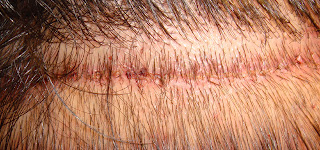Question: Exclusive use of single follicular units (SFU) seems to be the current norm, why does NHT insist on using mixed sized grafts?
Answer:
There are a number of reasons why many surgeons today use only SFU for hair transplants. Exclusively using SFU for hair transplants provides a more even "look" and fewer scabs immediately after surgery. As an additional benefit, surgeons can pack SFU more densely than modified follicular units.
However, there are three concerns:
1. Higher telogen (resting) stage hair loss due the process of thin graft preparation
Humans typically shed 60 to 100 hairs per day. These telogen stage hairs, or resting hairs, amount to 10% to 15% of our total hair at any given time. After about three months, the hairs re-grow and start the natural process over again. Telogen stage hairs are of concern for hair transplants because they are effectively invisible. In the process of preparing an SFU, the technician must trim off the tissue next to the SFU grafts possibly discarding the invisible hair inside the tissue. 10% to 15% of hair may be lost in this trimming process.
Photo: 10% to 15% of hairs are in Telogen Stage and are invisible.

2. Poorer growth rates when using thin grafts compared to "chubby" graft
Dr. Seager, Dr. Beener, Dr. Beeher, Dr. Reed and Dr. Raposio each conducted studies to compare the results of chubby and thin grafts. These studies found that re-growth rates for chubby grafts' are 20% to 51% more than the thin grafts. So far we haven't heard any report indicating that the thin graft's growth rates are better.
Photo: Thin follicular units-almost no tissue attached

Photo: Thin Follicular Units - tissues are trimmed off

Photo: Chubby Follicular Units

Photo: Chubby Modified Follicular Units

3. Cost to patient is almost double when using SFUs only
The cost associated with a hair transplant surgery is also an important issue. We work hard to earn our incomes - why should we waste it if we have a more affordable alternative to achieve our goal.
For example, here is a cost estimate for a typical SFU-only hair transplant for a hypothetical patient.
Assumes:
- A recipient area of 80 cm2
- A donor size of 40 cm2 needed for a 50% transplanted density
- Donor area contains about 100 FUs in one cm2
- Total grafts needed are around 4000 SFUs
- Total cost is around $20,000 at $5 per graft
In reality this surgery would likely cost much more than this estimate; in this calculation we didn't take into consideration potential hair loss during surgery or the growth rate.Remember that hair loss is a life long process. A patient needs to receive touch-up hair transplants once in a while to maintain a good "look". Over the longer term, the exclusive use of SFUs adds up to quite a sum!















